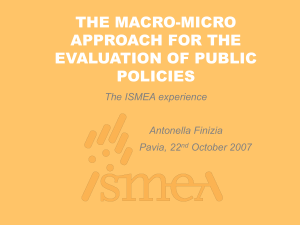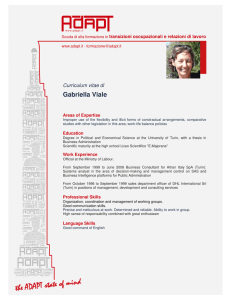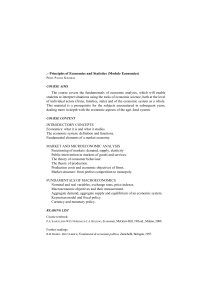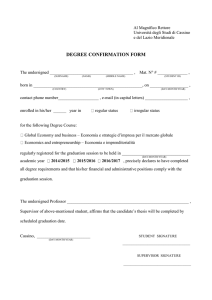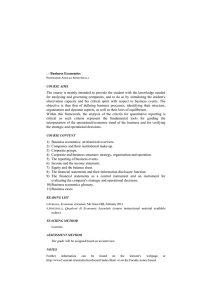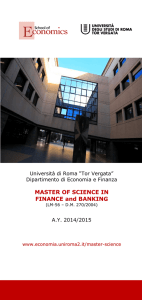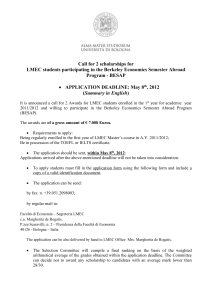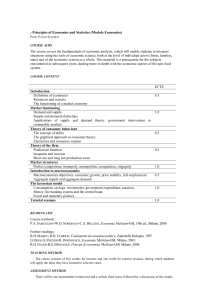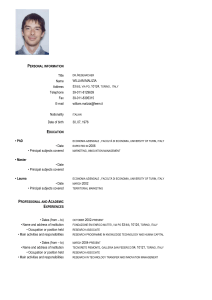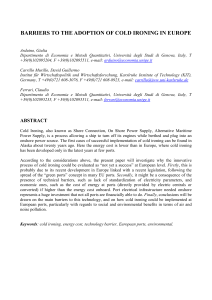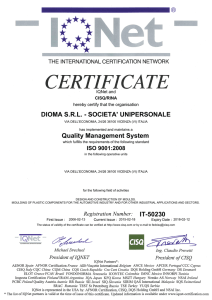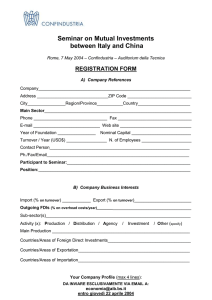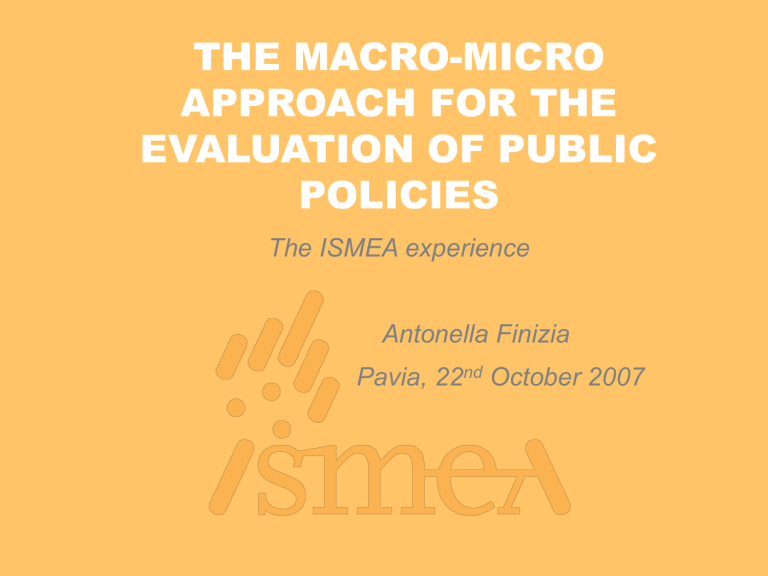
associazioneAlessandroBartola
studi e ricerche di economia e politica agraria
THE MACRO-MICRO
APPROACH FOR THE
EVALUATION OF PUBLIC
POLICIES
The ISMEA experience
Antonella Finizia
Pavia, 22nd October 2007
associazioneAlessandroBartola
studi e ricerche di economia e politica agraria
MAIN POINTS
What is ISMEA
Micro-macro approach
The ISMEA models
Macro simulations
Work in progress
Critical issues and conclusions
associazioneAlessandroBartola
studi e ricerche di economia e politica agraria
WHAT IS ISMEA
Institute of services for the agro-food markets
Linked to the Italian Ministry for agricultural and food
policy (MiPAAF), it is involved in:
farm and agro-food market information (prices,
production, consumption)
studies and research on the agro-food chain
financial and insurance services to farmers
support to public decisions
policy simulations
technical assistance
associazioneAlessandroBartola
studi e ricerche di economia e politica agraria
MICRO-MACRO APPROACH
The micro level: the farm household
The farm household can be considered as a macroeconomy in miniature
The family takes decisions about production and
consumption
economic dimension
Family
Farm
social dimension
environmental dimension
associazioneAlessandroBartola
studi e ricerche di economia e politica agraria
MICRO-MACRO APPROACH
The micro-macro link
The macro level can be obtained by aggregation from
the micro level (zooming out) and vice versa
A unique source of data is the basis for both the micro
and the macro models
The ISMEA Survey on socio-economic conditions of
Italian agriculture was designed having in mind these
theoretical model
associazioneAlessandroBartola
studi e ricerche di economia e politica agraria
MICRO-MACRO APPROACH
The ISMEA survey
Five surveys together
Farm budget data
Input/Output
Time Use Budget
Household Consumption Survey
Household Income Survey
The questionnaire modules were defined in coherence
with other surveys (Inea, Istat, Bank of Italy), to integrate
the information
associazioneAlessandroBartola
studi e ricerche di economia e politica agraria
MICRO-MACRO APPROACH
The ISMEA survey
Was designed to give all the information needed to
evaluate the impacts of policy changes
economic impact on farms (farm income)
socio-economic impact on households (life style,
welfare)
7 family farm typologies were defined, which represents
different targets for economic policy
associazioneAlessandroBartola
studi e ricerche di economia e politica agraria
ISMEA MODELS
The ISMEA Survey
o ISMEA I/O Tables
focused on agro-food
sectors
o SAM
Farm/Household
budgets
Households micro
models
o MEG ISMEA
o MEG-D ISMEA
o MEG-R ISMEA
Macro simulations
Micro simulations
(non behavioural)
Micro simulations
(behavioural)
associazioneAlessandroBartola
studi e ricerche di economia e politica agraria
MACRO SIMULATIONS
The Ismea CGE model peculiarities
It is focused on the agro-food sector, which is very
disaggregated: 23 sectors for Agriculture, Forestry and
Fishery, 13 for food industry, 7 for other industries strictly
linked to agriculture, 2 for services.
the SAM distinguishes 7 types of farm households;
1 group rural households; 3 urban households
classes
it includes the CAP market policy tools
associazioneAlessandroBartola
studi e ricerche di economia e politica agraria
MACRO SIMULATIONS
Which simulations?
Policy simulations
In 2004, MEG was used to evaluate the possible impacts
of Luxembourg CAP reform simulating different decoupling
options.
We are now working to simulate the consequences of milk
quotas abolition, with MEG-D.
Our clients are mainly MiPAAF; Unions of farmers
associazioneAlessandroBartola
studi e ricerche di economia e politica agraria
MACRO SIMULATIONS
Which simulations?
Simulations of future competitive scenarios
In 2005 and in 2007 different scenarios have been
simulated to evaluate the competitiveness of Italian
agriculture and food industry in 2015, considering different
hypothesis for CAP, international prices and productivity
evolution in the medium term.
Our clients are: MiPAAF; Federalimentare (Food Industries
Federation)
associazioneAlessandroBartola
studi e ricerche di economia e politica agraria
MACRO SIMULATIONS
Which simulations?
In 2007, an integration with GTAP CGE model has been
experimented.
A research regarding the role of three giants in the world
market: Brazil, China, India, and the competitive scenarios
for the Italian agro-food system.
A conjunct INEA-ISMEA study about milk quota
scenarios, commissioned by MiPAAF.
International price variations generated by GTAP model
are included in the shock for MEG-D exogenous variables.
associazioneAlessandroBartola
studi e ricerche di economia e politica agraria
WORK IN PROGRESS
Macro simulations
Updating the data-base
Regionalisation, by construction of 3 SAM (North,
Centre, South of Italy) and three integrated CGE models.
Constant upgrading in modelling agriculture,
following the deep evolution of the sector.
associazioneAlessandroBartola
studi e ricerche di economia e politica agraria
WORK IN PROGRESS
From macro to micro
In macro CGE models:
farms don’t leave the market and don’t enter in the
market (the “no production” option is not considered)
Even partial use of factors (land, labour) is not possible
Household members different choices can’t be
described
It is important to follow both the macro and micro
approach.
At micro level, we can better study the family behaviour
in reaction to a shock.
associazioneAlessandroBartola
studi e ricerche di economia e politica agraria
CRITICAL ISSUES
Data needs
The existence of a gap between official statistics for
agriculture and policy needs has now been recognized by
EC and Eurostat
The most important aspects are:
Connections between agriculture and food industry
Farm households characteristics and income
estimations
Links between the agro-food system and the rural
economy
Risk management in agro-food sector (market risks,
credit, food safety)
associazioneAlessandroBartola
studi e ricerche di economia e politica agraria
CONCLUSIONS
The approach conceived more than ten years ago is
still modern and even more valid now that the CAP
moves from market policy to rural policy.
One positive aspect of our models is their flexibility,
which consent to integrate in the macro models changes
in policy tools (for example, decoupling) or to distinguish
sectors or regions; this is possible because we have the
microdata coming from a unique, coherent source.
The demand of policy makers for quantitative
evaluations is increasing and especially for analysis at
regional and micro level.
The integration of data sources at institutional level is a
way to overcome the lack of information.

